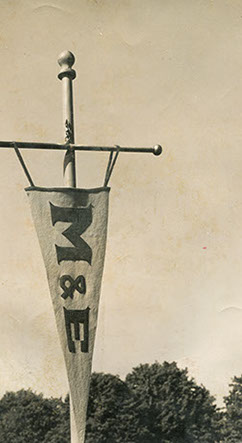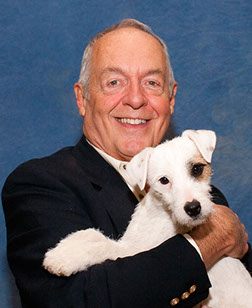
 Questions and Answers with Wayne Ferguson,
Questions and Answers with Wayne Ferguson,
M&E President and Show Chair
To what major factors do you attribute the great success of the Morris & Essex Kennel Club show?
Without question, our members' dedication and desire to continue the wonderful dog-show traditions Geraldine Rockefeller Dodge established in the 1920s-50s on her beautiful estate. She created the model of successful dog shows, and we simply follow her lead.
What qualities do you consider most important in show committee heads?
All of M&E's show-committee heads have years of experience with other kennel clubs and other dog shows and bring that level of expertise to our show. One of the most important assets of a great show committee head is the ability to work well with their committee members as well as gather support from the entire membership.
We are fortunate in that our Membership consists of many highly successful business people who bring that level of professionalism to the club and share their time and energy for the love of dogs and our special Morris & Essex dog show.
What is the most difficult thing involved in staging an event like yours?
Every five years we present a top-notch all-breed show with more than 100 club specialties and supported entries - thankfully, our numbers increase with every show. Raising the funds to exceed expectations and create a stellar event is always challenging - but brings a great deal of satisfaction.
Dog shows in general along with the entire nation's economy have been experiencing a downturn. What piece of "survival" advice would you give to show-giving clubs?
Morris & Essex survives and, in fact, thrives, because it's a dog show exhibitors, judges, and spectators all look forward to. Every five years they know that it will be a memorable day filled with period hats, box lunches, beautiful flowers, gorgeous grounds and tents, outstanding judging and attention to detail. It's fun, it's different, it's historic, it's memorable, and it is special.
Every kennel club has something that makes it special, makes it different, and focusing on that will help it survive.It's important to keep your entry fees as low as possible, be exhibitor friendly (with ring layouts, parking, judge selection, etc.), but it's most important to make it fun and give exhibitors, judges, and spectators something to look forward to that's different from every other dog show.
If you were in charge of all things “dog show,” what would be the first thing you would change or implement?
We stop the judging at twelve noon and everybody has lunch - judges, handlers, exhibitors, spectators - and it works. Superintendents run the shows but clubs need to run deeper into their judging panels. Clubs should have judges doing one, two or three breeds, not dozens, and then when the judges are finished they have done only a couple of hours of judging, can spend time talking with and educating exhibitors, and will have time for pleasantries during pictures.
What other considerations beyond knowledge of the breed or breeds they judge do you consider in hiring a judge?
They must care about the exhibitors and take time to answer questions - it's so important. Particularly if we want our sport to grow - it's important for the judge to speak to the novice handler and share what was good or what could be improved in the dog they showed that day.
Also, I believe that if a show chairman believes a judge might have a political reason for accepting an assignment, the show chairman shouldn't ask him or her in the first place.
What do you wish exhibitors at your show would be more aware of?
We spend about $7,000 in the five years between shows maintaining the public park grounds at our show site, Colonial Park - trimming trees, eliminating grubs, reseeding the grass, and getting the grounds ready for the show. There are big, beautiful big oaks which are so spectacular that we maintain through the intervening years. I wish that exhibitors would be more mindful of the show grounds - pick up their trash, don't spin wheels in the grass, and just really notice, appreciate, and care for the surroundings we are fortunate to have.
What do you wish judges at your show (or any show, for that matter) would be more aware of?
Morris & Essex judges are all wonderful, but I personally would like judges at all shows to encourage exhibitors to ask why their dog wasn't put up.
And then take the time to talk with and educate them - share their knowledge of the breed that they both obviously care about. I know it's difficult for judges, sometimes, but I believe people truly appreciate and learn from discussions with a judge at a show.
What effect do you feel cluster shows have had on the sport?
When I started showing my Saint Bernards in the 1960s, we had to travel many miles between shows on weekends - now exhibitors can show their dogs a few times within a few days in the same place, and I think it's great. I don't think these clusters should exceed four days, though. A five-day show is, in my opinion, too strenuous on the dogs and handlers.
What do exhibitors at your show seem to appreciate most?
Our delicious box lunches are a huge hit in keeping with the tradition Mrs. Dodge started - every exhibitor receives a free box lunch. Our trophies are exact replicas of the ones awarded in the 1920s-50s, and people love the display - the same as the one as at the original shows.
And, of course, I can't forget the hats. We encourage exhibitors, judges and spectators - men and women - to show off their hats. Everyone had so much fun dressing up in vintage clothes and hats at our shows!
Photo Perry Phillips
Quick Links
Morris & Essex Kennel Club Dog Show • Wednesday, October 1, 2025 • Colonial Park, 156 Elizabeth Ave., Somerset, NJ 08873 • morrisandessex@gmail.com


